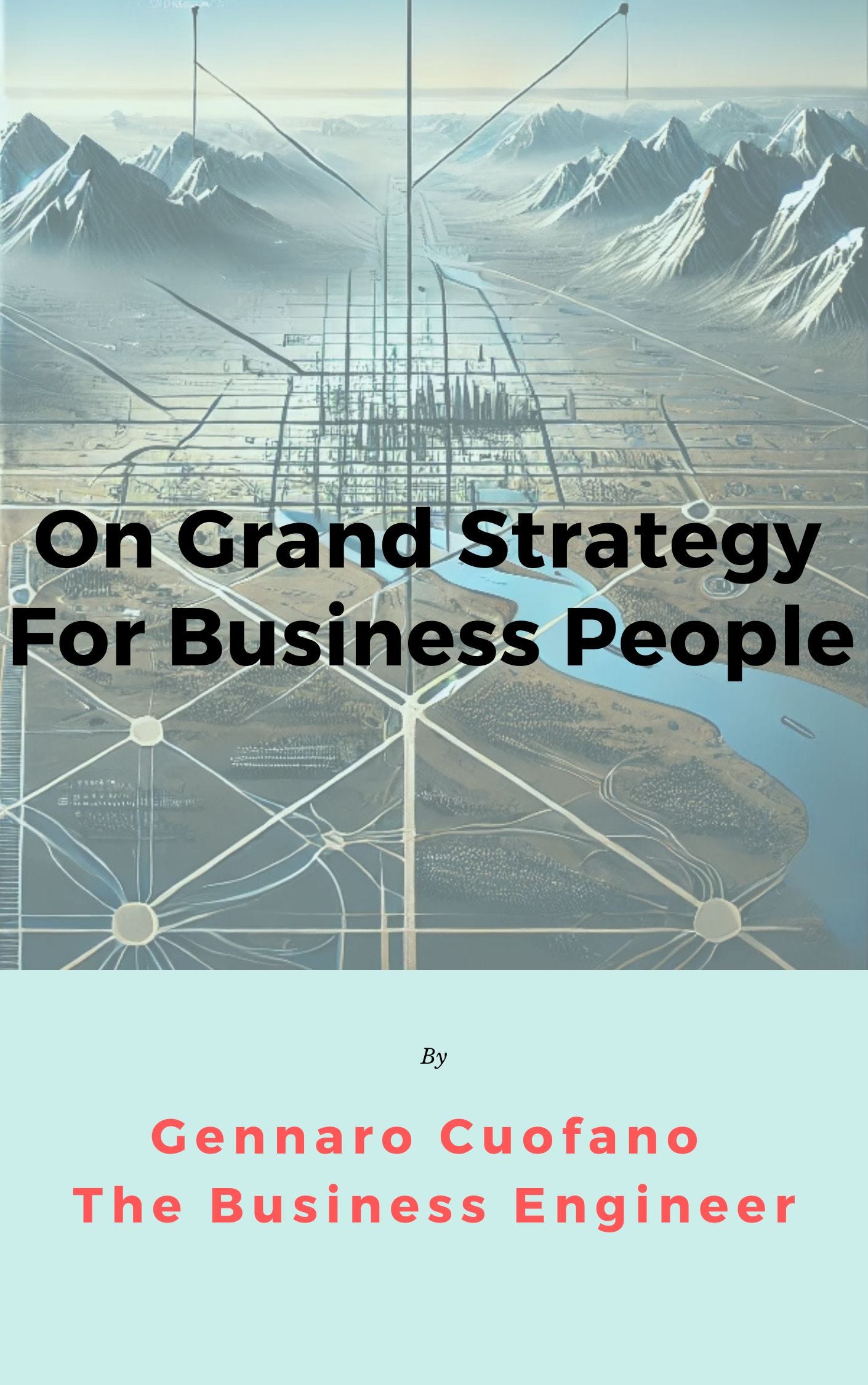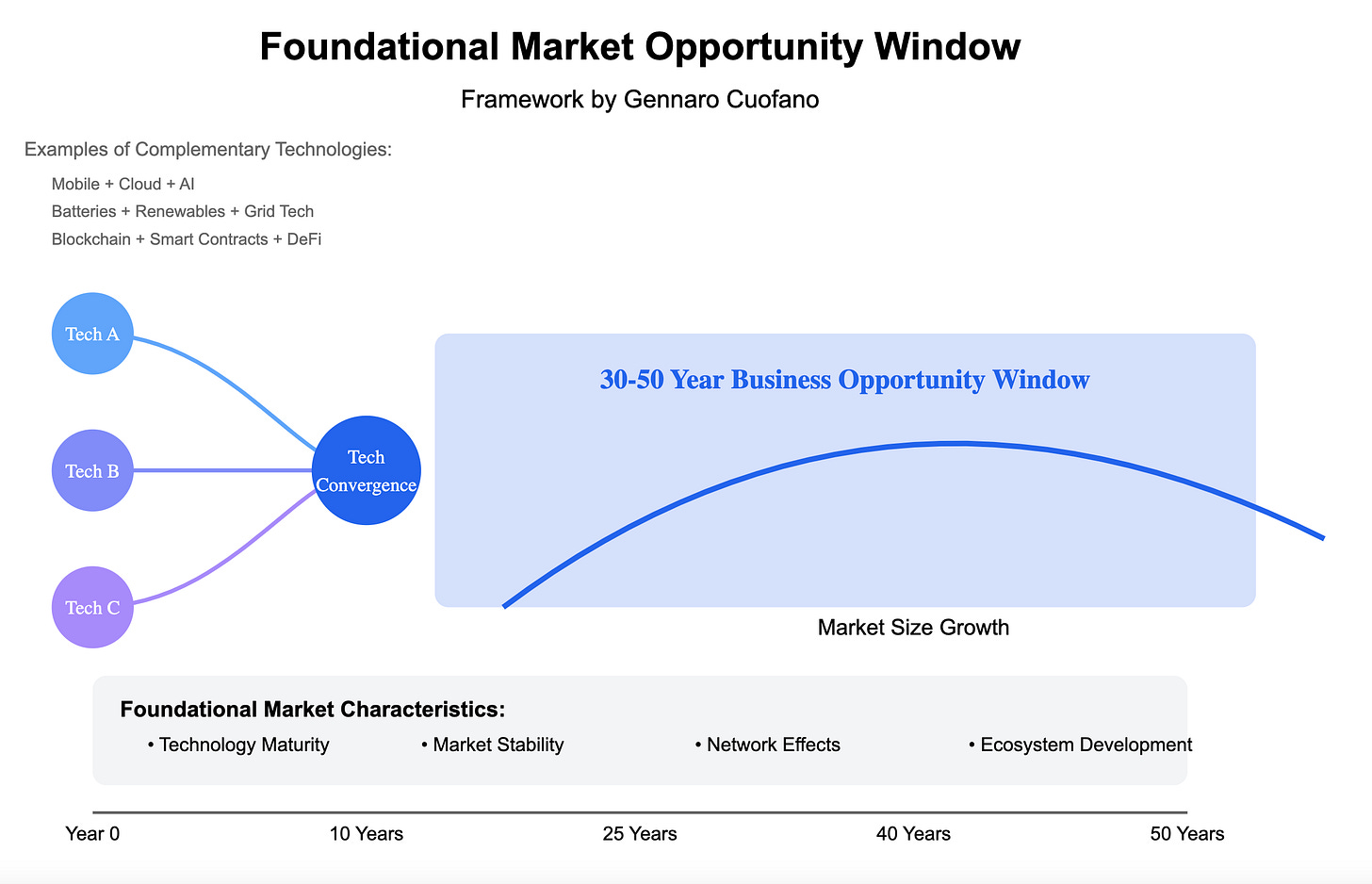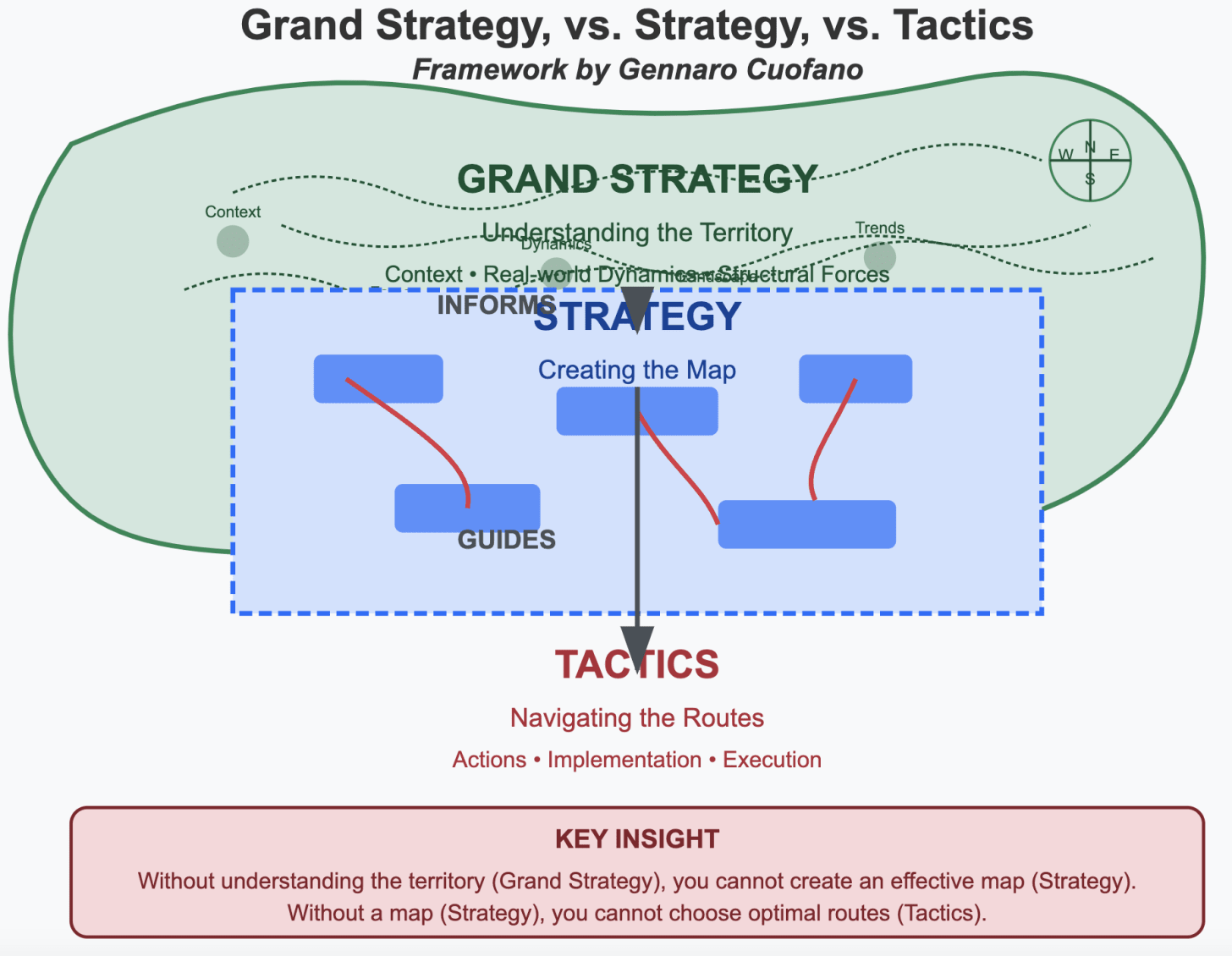
One of the major mistakes in business, which can be quite expensive, is to confuse strategy with tactics, or even worse, grand strategy with strategy.
Indeed, understanding context is the most valuable skill for a human being and, better yet, for a group of humans operating in the real world.
Context is like the territory. It’s like you are on a minefield, but you believe it’s a greenfield.
Understanding the territory is critical as it helps you discover the “rules of the game” you’re part of.
A territory, its shape, and its direction will be quite structural. It doesn’t matter how hard you try; it’ll be bigger than you.
This is part of the book Grand Strategy for Business People. Now available to our subscribers.
Thus, just like a giant wave that is coming, understanding the territory enables you to position yourself to ride that or avoid being wrecked by it.
Unless you believe you can shape the wave, only a few can.
The reason is that many of the massive changes that come, especially in the tech world, are part of what I’ve defined as “fundamental or foundational shifts.”
These are often the result of a tech convergence, where a few technologies become fully viable at once, accelerating the speed of progress in a much broader industry.
Thus, going back to grand strategy, that is what it means to understand the territory.
It will inform you of the real-world dynamics within which you can operate in the first place.
Reading that structure and understanding the underlying territory is a grand strategy.
From there, you need a map.
Or a way to navigate that territory once you’ve understood it, even intuitively.
That’s what strategy is: it’s the temporary map that you have drafted as a result of having understood the territory, its dynamics, and the way it’s shaped.
But also the way it’s changing or has changed.
That is why, without a grand strategy, there is no strategy.
The map follows the territory.
You can formulate tactics once you have mapped the context based on the underlying territory.
Tactics are all the possible routes to move on that map based on the territory.
Once again, there is no single route; many are possible, and a few will lead in the right direction on the map.
Each will bring you closer to the territory where you can achieve the most as a person or business.
Thus, from here, it is derived that there’s no effective strategy without a grand strategy. And not good routes without the map, thus the strategy.
Keep that in mind!
-
Grand Strategy = Territory (Structural/Contextual)
-
Strategy = Map (Navigational/Directional)
-
Tactic = Routes (Operational/Executional/Optional)
The book establishes a clear hierarchy:
-
Grand Strategy = The Territory (Structural/Contextual): This is the foundational understanding of an organization’s environment. It involves grasping the “rules of the game,” broader shifts, and underlying dynamics. The book states, “Understanding context is the most valuable skill for a human being and, better yet, for a group of humans operating in the real world.” It’s about recognizing the “minefield” versus a “greenfield.”
-
Strategy = The Map (Navigational/Directional): Strategy is the temporary plan developed after understanding the territory. It acts as a navigational tool, outlining key areas, boundaries, and objectives to move within the identified context. “That’s what strategy is, it’s the temporary map that you have drafted as a result of understanding the territory, its dynamics, or the way it’s shaped.”
-
Tactic = Routes (Operational/Executional/Optional): Tactics are the specific actions and routes taken to move on the strategic map and achieve objectives. Multiple routes are possible; the selection depends on the evolving context and map. “Tactics are all the possible routes to move on that map based on the territory.”
A central argument is that “there’s no effective strategy without a grand strategy. And not good routes without the map, thus the strategy.” Confusing these levels is a “major mistake in business” that can be “quite expensive.”
Understanding the territory (grand strategy) involves a three-pronged approach:
This focuses on how well an organization fits the current and shifting territory. It comprises two key elements:
-
External Forces (Understanding the Environment): Analyzing factors beyond the organization’s direct control:
-
Macro Trends: Technological shifts, economic factors, social and demographic changes. Questions include: “What social or demographic shifts (urbanization, aging populations, changing values) impact customer behavior?”
-
Industry Dynamics: Competitive forces, market evolution, industry structure. Questions include: “Who are our biggest competitors, and how are they evolving?”
-
Regulatory Environment: Policy changes, geopolitical factors, standards evolution. Questions include: “What new laws, compliance rules, or regulations are coming that could impact our operations?” and “Are there geopolitical risks (trade wars, sanctions, political instability) that could affect our business?”
-
Customer Landscape: Behavior shifts, unmet needs, decision journeys. Questions include: “How are customers making buying decisions, and how can we influence their journey?”
-
-
Internal Capabilities (Assessing Your Position): Evaluating the organization’s strengths and weaknesses:
-
Core Assets: Proprietary technologies, data & information, brand & reputation. Questions include: “What proprietary technologies, patents, or intellectual property give us a competitive edge?” and “Do we have a strong and recognizable brand that builds customer trust?”
-
Resource Base: Financial capital, human capital, operational infrastructure. Questions include: “Do we have sufficient financial reserves or access to funding for growth?” and “Do we have the right talent and leadership to execute our strategy?”
-
Organizational Capabilities: Decision-making, adaptability, innovation systems, strategic positioning. Questions include: “What is our unique value proposition, and how does it differentiate us from competitors?” and “Are we positioned well in the market (pricing, brand perception, customer relationships)?”
-
The Adaptability Framework emphasizes leveraging internal capabilities to navigate the external territory effectively. “Adaptability is the ability to leverage the company’s internal capabilities to move along the external territory to produce the best outcome and avoid traps in the territory that might hamper the whole business while getting close to the long-term goals and vision.”
This framework structures strategic planning across different timeframes to balance immediate needs with long-term vision:
-
Immediate Horizon (0-2 Years): Tactical responses to the current territory, focusing on current competitive dynamics, ongoing initiatives, and immediate market shifts. The key question is: “What territorial features require immediate response or adaptation?”
-
Mid-Term Horizon (3-5 Years): Strategic repositioning for the emerging territory, focusing on emerging technologies, shifting business models, and evolving customer needs. The key question is: “What territorial transformations require strategic repositioning?”
-
Long-Term Horizon (6-10+ Years): Visionary exploration of future territory, focusing on major paradigm shifts, disruptive forces, and structural industry changes. The key question is: “What entirely new territories might emerge that require reimagination?”
Multi-Horizon Integration is crucial, requiring a balance of investments across these horizons to ensure both survival and evolution. “Balance investments across horizons to ensure both survival and evolution.”
This involves categorizing trends and uncertainties based on their strategic impact and level of uncertainty:
-
Core Focus (High Impact, Low Uncertainty): Invest aggressively in these strategic certainties. The key question is: “What trends are shaping the competitive landscape that we must invest in now?”
-
Key Uncertainties (High Impact, High Uncertainty): Hedge by preparing for multiple scenarios and keeping options open. The key question is: “What critical uncertainties could significantly impact our industry, and how can we prepare for multiple scenarios?”
-
Monitor Only (Low Impact, Low Uncertainty): Track these background context trends to ensure they do not evolve into major shifts. The key question is: “Which trends should we track to ensure they do not evolve into major industry shifts?”
-
Contingency Plan (Low Impact, High Uncertainty): Scout these potential wildcards and be prepared to pivot if they gain momentum. The key question is: “What potential wildcards should we keep an eye on in case they become disruptive?”
Strategy translates the understanding of the territory into a navigable map. The Strategic Map framework uses four quadrants based on the current and future state:
-
Current State:
-
Future State:
Strategic transitions involve moving between these quadrants, often sequentially (e.g., from Attacking new markets to Transforming the business model).
Tactics involve selecting and navigating specific routes to execute the strategy within the defined territory. Key elements include:
-
Route Selection Criteria: Alignment with the map, resource efficiency, risk-reward balance, time considerations, and adaptability.
-
Implementation Principles: Clear milestones and metrics, continuous monitoring, quick decision loops, and strategic coherence.
-
Route Selection Matrix: Categorizing routes based on business strategy context (Vertical, Horizontal, Diagonal, Combination).
The Impact vs. Effort Prioritization Matrix helps prioritize tactical initiatives for the short term, identifying “Quick Wins,” “Major Projects,” “Fill-Ins,” and areas to “Reconsider.” The Tactical Sequencing Framework provides guidance on the optimal order of implementation.
The book uses Google as a primary case study to illustrate the application of these frameworks. Examples are provided for:
-
Contextual Adaptability: Analyzing macro trends (AI Revolution, Web² Transition), industry dynamics (Shift to “Cognitive Discovery,” ChatGPT threat), regulatory environment (AI Regulation), and customer landscape (AI-Native User Experiences), as well as Google’s internal capabilities (Search & Ad Infrastructure, AI Talent Pool, Financial Resources).
-
Time Horizon Analysis: Outlining Google’s focus areas and actions within the Immediate (managing current competition, optimizing core products), Mid-Term (AI-driven growth, ecosystem expansion), and Long-Term (post-search paradigm, autonomous systems) horizons.
-
Multi-Horizon Strategic Map: Categorizing Google’s initiatives into Operational Excellence (Chrome security), Market Momentum (Gemini AI launch), Capability Building (AI infrastructure), and Future Creation (Waymo, new revenue models).
-
Contextual Mapping: Placing various trends and uncertainties (e.g., Gemini scaling as Core Focus, ChatGPT as Key Uncertainty, Quantum computing as Contingency Plan) on the impact vs. uncertainty matrix for Google.
-
Strategic Map: Illustrating Google’s strategic movement from defending its core and attacking new AI opportunities in the current state to transforming its business with AI and creating entirely new markets in the future.
-
Context is Paramount: Understanding the territory (grand strategy) is the foundation of all effective strategic action. Missing the context can lead to significant failures.
-
Hierarchy Matters: Grand strategy, strategy, and tactics are distinct but interconnected levels. Confusing them hinders effective execution.
-
Adaptability is Essential: Organizations must continuously assess and adapt to the changing external environment by leveraging their internal capabilities.
-
Time Horizon Planning Provides Balance: Strategically managing short, medium, and long-term horizons ensures both immediate survival and future growth.
-
Managing Uncertainty is Key: The Contextual Map helps organizations allocate resources appropriately based on the impact and predictability of external factors.
-
Strategic Maps Guide Transitions: Visualizing the desired future state and the steps to get there through strategic quadrants provides clarity and direction.
-
Tactical Prioritization Optimizes Execution: Using frameworks like the Impact vs. Effort matrix ensures resources are focused on the most impactful short-term actions aligned with the overall strategy.
With massive ♥️ Gennaro Cuofano, The Business Engineer
This is part of the book Grand Strategy for Business People. Now available to our subscribers.





![On Grand Strategy [Book Inside]](https://som2nynetwork.com/wp-content/plugins/phastpress/phast.php/c2VydmljZT1pbWFnZ/XMmc3JjPWh0dHBzJTNBJTJGJTJGc29tMm55bmV0d29yay5jb20lMkZ3cC1jb250ZW50JTJGdXBsb2FkcyUyRnRodW1ic19kaXIlMkYxNzQ0MDI0NTEzXzEtcjQwN3l4OGZucGlrNm95cnMwcGNubzFoZWdyY2thaXVkbXI0OGw4NHpnLnBuZyZjYWNoZU1hcmtlcj0xNzQ0NDQwOTc1LTMxNTcmdG9rZW49YjUyNWE5MjU1OGJkZjUwMQ.q.png)



